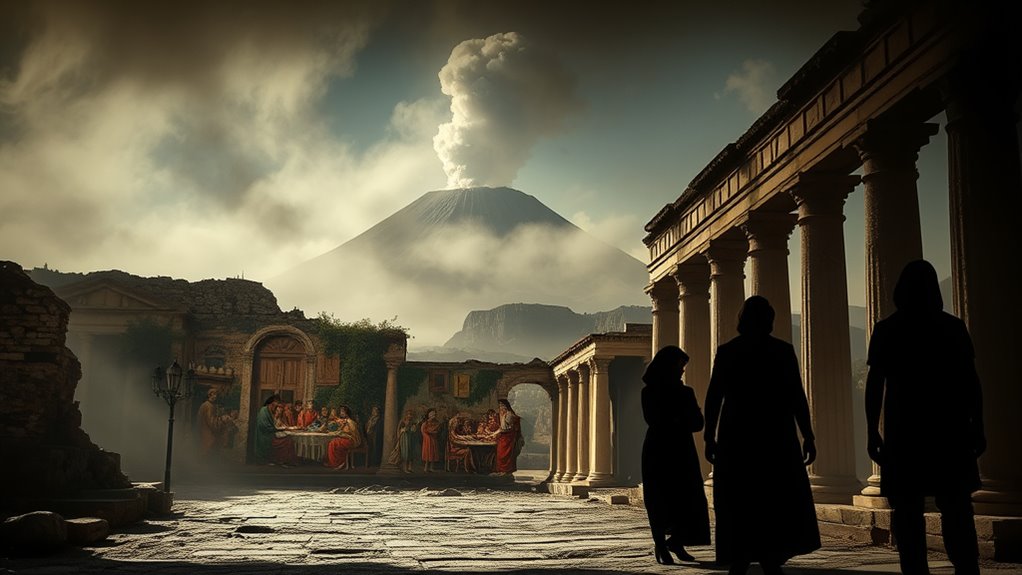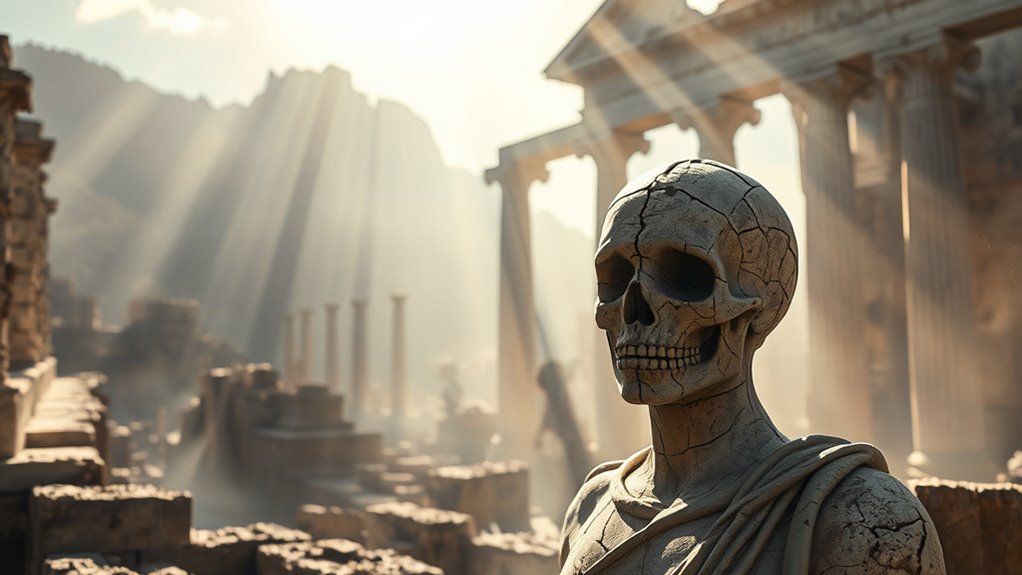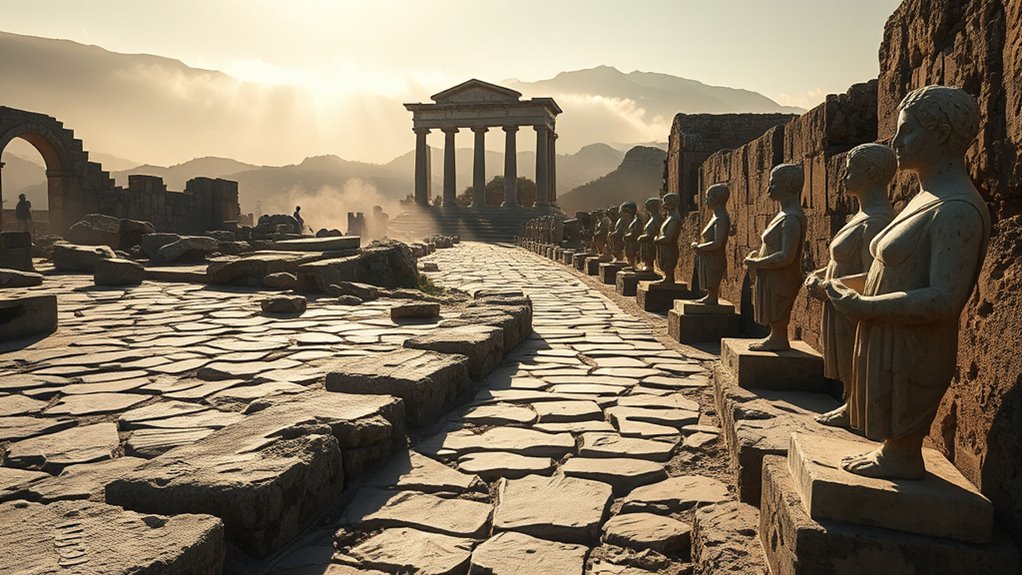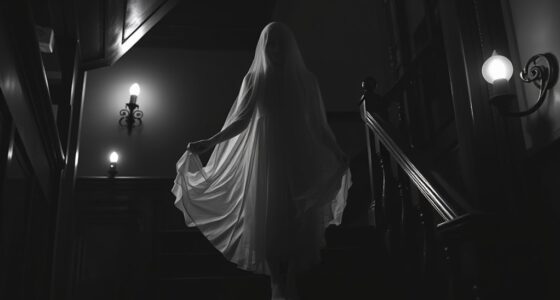As you wander the haunting ruins of Pompeii, you can feel the presence of lost souls from that fateful day in 79 A.D. The ghosts of victims linger in the shadow of Vesuvius, reminding you of the vibrant life that once thrived here. Old homes and echoes of celebrations contrast with the sorrow captured in the preserved remains. Each step stirs feelings of awe and melancholy, beckoning you to uncover deeper stories of this tragic history.
Key Takeaways
- The tragic eruption of Vesuvius in 79 A.D. instantaneously claimed 15,000 lives, leaving behind haunting voids of victims preserved in ash.
- Rediscovered in 1748, Pompeii’s excavation revealed a lost world, enriching our understanding of ancient Roman culture and its tragic fate.
- Superstitions surround stolen relics from Pompeii, with visitors reporting misfortunes attributed to disrespecting the site and its tragic past.
- Nature’s harmony with Pompeii’s ruins creates a poignant atmosphere, where wildlife coexists with the echoes of lost souls, deepening emotional connections.
- Encounters with the preserved remains evoke a complex blend of awe and sadness, prompting reflection on mortality and the resilience of life amidst loss.
The Eruption of Vesuvius: A Moment of Catastrophe

As the sun set on August 24, 79 A.D., the peaceful towns of Pompeii and Herculaneum were about to face an unimaginable disaster.
Mount Vesuvius erupted violently, sending an ash cloud soaring nearly 20 miles into the sky. This toxic mix of ash and gas obliterated human life instantly, claiming an estimated 15,000 souls.
The eruption uprooted buildings and swept them away with ferocious force, burying the cities under layers of volcanic debris.
The eruption violently dismantled structures, entombing Pompeii and Herculaneum beneath thick layers of volcanic debris.
In the aftermath, the unique archaeological site revealed haunting voids where victims once stood, allowing for detailed body casts that capture their final moments.
This catastrophic event not only devastated lives but also preserved a snapshot of Roman society, shedding light on their vulnerabilities and daily existence.
Life and Culture in Pompeii Before the Eruption

Imagine walking through the bustling streets of Pompeii, where daily life buzzes with activity and community spirit.
You’d witness a society rich in cultural celebrations and festivals, highlighting the importance of social dynamics and hierarchy.
Each moment reflects the vibrant tapestry of life before Vesuvius changed everything forever.
Daily Life Activities
Daily life in Pompeii buzzed with energy and vibrancy, reflecting a rich tapestry of culture and community.
You’d find locals bustling through markets, where artisans showcased their ceramics and fresh produce. Daily life activities included attending lively festivals filled with music and dance, or competing in sports events that drew large crowds.
Even though the city thrived on trade and agriculture, families enjoyed the comforts of their luxurious homes, complete with intricate frescoes and private gardens.
The aroma of cooked meals wafted through the streets, a reflection of Pompeii’s culinary practices. Engaging in communal festivities and supporting local merchants, residents forged strong bonds, making life in this ancient city a unique blend of work and enjoyment.
Social Hierarchy Dynamics
While the vibrant streets of Pompeii thrummed with life, a clear social hierarchy defined the interactions among its residents. Wealthy citizens, like Lucius Caecilius Lucundus, occupied grand homes adorned with art and gardens, showcasing their status.
In contrast, the majority of the population, many of whom had origins as slaves, lived much smaller and simpler lives, reflecting the complexities of social status. Women contributed to the economy by managing households and participating in businesses, challenging the notion of them being mere second-class citizens.
The social hierarchy dynamics shaped every aspect of life, from trade and agriculture to cultural activities, weaving a rich tapestry of communal identity before the catastrophic eruption disrupted everything.
Cultural Celebrations and Festivals
Life in Pompeii thrived not just through its social hierarchy but also through vibrant cultural celebrations that brought the community together.
Festivals dedicated to gods like Bacchus filled the streets with music, dancing, and theatrical performances, showcasing the city’s devotion and customs.
The Ludi, honoring Jupiter and Neptune, featured thrilling athletic competitions and gladiatorial contests that drew large crowds and fostered a strong community spirit.
Annual celebrations like Parilia honored fertility, with rituals that blessed the fields and livestock, while the Vinalia festival celebrated the grape harvest with lively wine-drinking festivities.
The amphitheater buzzed with theatrical acts, reflecting Pompeii’s appreciation for the arts.
These cultural celebrations were essential to the daily life and identity of the Pompeians.
The Rediscovery of Pompeii: Unveiling the Past

When Pompeii was rediscovered in 1748, it opened a window into a long-lost world, sparking new interest in ancient Roman culture.
As you explore the excavated ruins, you’ll notice how these artifacts not only tell stories of daily life but also influence modern archaeological research.
Each find deepens our understanding of the past and highlights the devastating impact of natural disasters on human civilization.
Uncovering Ancient Ruins
As you step into the ancient streets of Pompeii, the echoes of a vibrant civilization come alive, thanks to its rediscovery in 1748.
You’ll find well-preserved ruins—homes, businesses, and public buildings—that reveal the daily life of its citizens. The layers of volcanic ash have captured the last moments before the eruption, allowing you to witness artefacts and remains that tell haunting stories.
As you wander through the eerie atmosphere, you might even hear whispers in the quiet streets, deepening your connection to this lost world.
Ongoing excavations continue to disclose secrets of Pompeii, enriching your understanding of its social dynamics and cultural practices, making every visit a journey through time.
Impact on Archaeological Research
The rediscovery of Pompeii in 1748 fundamentally transformed archaeological research, opening a window into a long-lost world.
You’ll find that this remarkable site revealed extensive remains of Roman life and culture, including:
- Well-preserved structures and artifacts that showcase daily activities.
- Mosaic tiles that illustrate the artistry and craftsmanship of the time.
- Innovative plaster casts of victims, capturing their final moments.
- Organic materials found in Herculaneum, enriching our understanding of domestic life.
These findings have reshaped our perceptions of ancient Pompeians, highlighting social dynamics and the roles of women.
Ongoing excavations continue to challenge preconceived notions, making Pompeii an essential chapter in the story of human history and archaeological discovery.
The Haunting Spirits of Pompeii: Echoes of Tragedy

Although centuries have passed since the catastrophic eruption, the haunting spirits of Pompeii remain, echoing the tragedy that claimed thousands of lives.
These ghosts of Pompeii are believed to be the souls of those who perished, lingering in their former homes and reflecting the luxury once enjoyed.
Despite the passage of time, the essence of familial roles persists among the spirits, as mothers, fathers, and children maintain their identities.
Nature intertwines with these spectral remnants; playful cats roam the ruins, while blackbirds symbolize the release of sorrow into the air.
Visitors often report an eerie atmosphere, where encounters with these spirits evoke deep reflections on mortality, reminding you of the complex relationship between life and death that defines this haunting site.
Superstitions and Curses: The Legacy of Stolen Relics

When you step into the ruins of Pompeii, it’s hard to ignore the whispered tales of misfortune that surround stolen relics. Many believe in the curses linked to these artifacts, often attributing personal tragedies to their ill-fated decisions.
Stepping into Pompeii reveals whispered tales of misfortune tied to stolen relics, invoking a haunting respect for its tragic history.
Here are a few common superstitions:
- Removing relics invites negative energy into your life.
- Tourists who’ve stolen items often feel compelled to return them after experiencing bad luck.
- Stories circulate about the misfortunes of those who ignored warnings from tour guides.
- The belief in karma remains strong, reflecting the interconnectedness of actions and consequences.
This legacy of curses serves as a haunting reminder of Pompeii’s tragic history and the respect it demands from its visitors.
Nature’s Role: Coexistence With the Ghosts of Pompeii

Stepping into the ruins of Pompeii, you can sense a unique harmony where nature intertwines with the echoes of the past. The power of nature is evident as abandoned homes and public spaces become serene habitats for wildlife.
Cats lounge lazily among the ruins, embodying the playful spirits of the lost souls, while blackbirds flit about, symbolizing the release of sorrow tied to the tragedy. Lush vegetation softens the harsh reminders of the catastrophic eruption, creating a tranquil atmosphere for you to reflect.
Animals interacting with these remnants highlight the ongoing relationship between nature and history, reminding you of life’s resilience amidst loss. Here, nature not only coexists with the ghosts but also nurtures their memories.
Visitor Experiences: Reflections on Mortality and Memory

As you wander through the haunting remnants of Pompeii, a wave of mixed emotions washes over you; awe intertwines with a profound sadness as you confront the lives forever altered by the eruption of Mount Vesuvius.
You might find yourself reflecting on your own mortality as you consider:
- The preserved remains that evoke guilt and respect for those who suffered.
- Encounters with lingering spirits, connecting you to the past.
- The eerie atmosphere, where whispers seem to echo the lives lost.
- The undeniable urge to return, driven by a complex blend of fear and fascination.
Each step through Pompeii amplifies your contemplation of life, death, and the memories that echo through time, leaving an indelible mark on your soul.
Frequently Asked Questions
What Is the Tragic Story of Pompeii?
The tragic story of Pompeii unfolds on a fateful day in 79 A.D., when Mount Vesuvius erupted, releasing a torrent of ash and pumice.
You can imagine the chaos as residents tried to escape, unaware of the impending disaster. Thousands lost their lives, and the city was buried beneath layers of volcanic debris.
This catastrophe not only claimed lives but also preserved a glimpse into daily life, leaving haunting reminders of what once was.
What Was the Curse of Pompeii?
Imagine stepping into a world where ancient whispers warn you of lurking shadows.
The curse of Pompeii revolves around tourists who take artifacts from the site, believing they’ve awakened a tragic history. Many confess to experiencing misfortunes, attributing their bad luck to this curse.
You’ll hear tales from locals and guides about spirits seeking retribution for disturbing their resting place, merging history with supernatural lore, creating an eerie connection to the past.
What Is the Story of Pompeii About?
The story of Pompeii is about a vibrant Roman city that faced a tragic fate when Mount Vesuvius erupted in 79 A.D.
You’ll find a snapshot of life frozen in time, with homes, businesses, and public spaces preserved under layers of ash.
As you explore the ruins, you’ll uncover the daily lives of its inhabitants and confront the profound loss experienced by thousands, making it a poignant reflection on both life and mortality.
Is Pompeii a Ghost City?
Yes, Pompeii’s often called a ghost city.
When you walk through its ancient streets, you can almost feel the presence of those who once lived there. The ruins tell stories of a vibrant past, and many visitors sense an eerie connection to the souls lost in the volcanic eruption.
As you explore, you might even encounter playful cats or hear echoes of laughter, reminding you of the lives that existed before tragedy struck.
Conclusion
As you wander through the haunting ruins of Pompeii, remember the adage, “Those who cannot remember the past are condemned to repeat it.” The ghosts of this tragic city linger, reminding you of the vibrant life that once thrived here and the catastrophic eruption that silenced it. Each artifact and shadow tells a story, inviting you to reflect on mortality and the fragility of existence. Embrace the echoes of Pompeii, for they speak of resilience amidst devastation.









